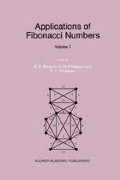Abstract
To prove or disprove the existence of a perfect box is an old unsolved problem (see [2,4]). Here a perfect box or cuboid means a rectangular parallelepiped with all edges, face diagonals and space diagonals of integer lengths. More general, in [5] combinatorial boxes are considered, that are, convex bodies with six quadrilaterals as faces. These bodies then also have 8 vertices and 12 edges. In [5] the existence of integral combinatorial boxes is proved by the presentation of 20 examples where all edges, face diagonals and space diagonals are of integer lengths. It is conjectured in [5] that one of these examples (see Figure 1) is the smallest integral combinatorial box, that means, that the largest distance between any two vertices, 17 in this case, is the minimum of any largest integer distance between vertices of all integral combinatorial boxes. Here we will prove that up to this largest distance 17 other integral combinatorial boxes do not exist.
Access this chapter
Tax calculation will be finalised at checkout
Purchases are for personal use only
Preview
Unable to display preview. Download preview PDF.
References
Berger, M. Geometry I. Springer-Verlag, Berlin 1987.
Guy, R.K. Unsolved Problems in Number Theory. Springer-Verlag, New York 1981.
Harborth, H., Kemnitz, A. and Möller, M. “An upper bound for the minimum diameter of integral point sets.” Discrete Compnt. Geom., Vol. 9 (1993): pp. 427–432.
Klee, V. and Wagon, S. Old and New Unsolved Problems in Plane Geometry and Number theory. Mathematical Association America (MAA) 1991.
Peterson, B. E. and Jordan, J. H. “Integer hexaedra equivalent to perfect boxes.” American Mathematical Monthly, Vol. 102 (1995): pp. 41–45.
Peterson, B.E and Jordan, J. H. “The rational heart of the integer Fibonacci pentagons.” Applications of Fibonacci Numbers. Volume 6, Kluwer Academic Publishers. Edited by G.E. Bergum, A. N. Philippou and A. F. Horadam, 1996, pp. 381–388.
Wagner, J. “Integer hexaedra.” Preprint 1993.
Editor information
Editors and Affiliations
Rights and permissions
Copyright information
© 1998 Springer Science+Business Media Dordrecht
About this chapter
Cite this chapter
Harborth, H., Möller, M. (1998). Smallest Integral Combinatorial Box. In: Bergum, G.E., Philippou, A.N., Horadam, A.F. (eds) Applications of Fibonacci Numbers. Springer, Dordrecht. https://doi.org/10.1007/978-94-011-5020-0_19
Download citation
DOI: https://doi.org/10.1007/978-94-011-5020-0_19
Publisher Name: Springer, Dordrecht
Print ISBN: 978-94-010-6107-0
Online ISBN: 978-94-011-5020-0
eBook Packages: Springer Book Archive

